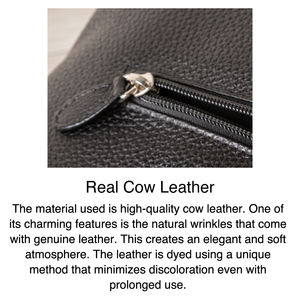Title: How to Identify Real Leather
How to Identify Real LeatherLeather is a natural material that has been used for centuries to make clothing, footwear, and accessories. However, with the rise of synthetic materials, it can be difficult to identify real leather from fake leather.One of the most effective ways to identify real leather is to look for signs of animal skin on the surface. Real leather will often have natural markings, such as pores or hair follicles, that are unique to each animal. Synthetic materials, on the other hand, will often have a uniform or repetitive pattern that is easily noticeable.Another clue that can help you identify real leather is to feel the texture of the material. Real leather has a natural softness and elasticity that synthetic materials often lack. When you touch real leather, it should feel like a living thing, while synthetic materials may feel cold or plastic-like.Finally, if you are still uncertain whether the leather is real or fake, you can try to find a reputable leather dealer who can authenticate the material for you. They will be able to use specialized techniques to determine the authenticity of the leather and provide you with a definitive answer.In conclusion, identifying real leather from fake leather can be challenging but not impossible. By looking for signs of animal skin, feeling the texture of the material, and seeking professional authentication if necessary, you should be able to determine whether the leather you have is real or fake.
Real leather is a term that can be used to describe any type of leather that is made from natural animal skin. It is often confused with fake or synthetic leather, which are made from materials that imitate the look and feel of real leather. Leather goods are popular for their durability, quality, and luxurious feel, but it can be difficult to determine whether or not a leather product is real. In this article, I will provide some tips on how to identify real leather.
1、Examine the Surface: Real leather has a unique texture and pattern that is created by the skin of the animal it comes from. The surface of real leather will often have imperfections, such as scratches, wrinkles, or unevenness. These are all natural and normal characteristics of real leather. On the other hand, synthetic leather will often have a smoother, more consistent surface.
2、Feel the Texture: Real leather has a soft, supple texture that is difficult to replicate in synthetic materials. When you touch real leather, it should feel like it has some give to it, and it should be warm to the touch. Synthetic leather, on the other hand, may feel cooler or more stiff.

3、Check the Labels: Many leather products will have labels or tags that indicate the type of leather it is made from. For example, you may see labels that say “real leather”, “genuine leather”, or “authentic leather”. These labels are often a good indicator that the product is indeed made from real leather. However, it is always best to double-check with other methods to be sure.
4、Consider the Weight: Real leather is often heavier than synthetic leather. This is because real leather has more natural fibers and is not as densely packed as synthetic materials. Synthetic leather, on the other hand, may feel lighter and more artificial.

5、Evaluate the Quality: Real leather is often considered to be of higher quality than synthetic leather. This is because real leather is made from natural materials and has been processed in a way that preserves its natural quality and integrity. Synthetic leather, on the other hand, may have been processed using chemicals or other artificial methods that can affect its quality and durability.
In conclusion, identifying real leather can be challenging but not impossible. By examining the surface, feeling the texture, checking the labels, considering the weight, and evaluating the quality of a leather product you can make a more informed decision about its authenticity. Always remember to trust your senses and look for those natural characteristics that are unique to real leather.

Articles related to the knowledge points of this article:
Title: The Art of Tie Clip Positioning: A Guide to Mastering the Perfect Bow Tie
Title: Mastering the Art of Tie Cleaning: A Comprehensive Guide
Cleaning Jackets: A Guide to Caring for Your Down Coat
Pink Short-款的 Winter Jacket: Fashion and Comfort in Cold Weather
Title: The Art of Tying a Silk Scarf and Belt: A Comprehensive Guide



